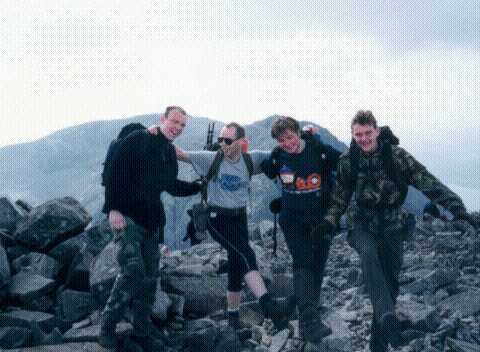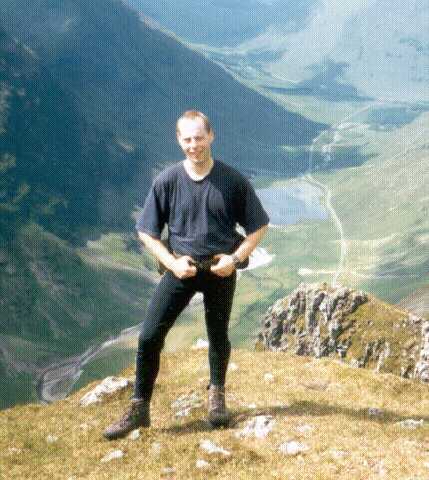People tend to complicate things, all
you need to get
started on a long and wonderful life in the hills is
enthusiasm. Forget about how much money the latest gear costs,
navigating at night in the Cairngorms and worrying about the difference
between scrambling and climbing, as long as you are keen you'll be
alright. Now we have established how keen you are, if you lead a
reasonably active life you will have a head start on those that do not.
These days we have access to absolute acres of information, if you don't
know friends that are keen on the hills you can read books in libraries,
get magazines on the subject ranging from short walks to full on
Himalayan mountaineering. There are videos, tv shows, local walking
shops and clubs, oh yes, and there's the web.
I was very fortunate in that my Father enjoyed walking outdoors, albeit
mainly locally, but it gave me that initial boost. I learnt navigating
in the TA which has since proved vital but don't get overwhelmed by
things, take it one experience at a time and you should be ok. For those
who want to make up for lost time or want to learn most things in a
week, courses run by outdoor organizations such as those at Plas Y
Brenin in North Wales are fantastic. They run specialist courses in rock
climbing and canoeing, fromweekend tasters to full blown assesment
courses for those leading others or who might want to chose a career in
the outdoors (lucky gits).
|

It doesn't have to be all serious-Scafell Pike |

Pretty Essential I would have thought, as well as knowing how to use
them of course.
Return to Home Page 
Return to Main Menu
View The
Picture Gallery
Click here to email me at daveswalking@aol.com
|
| For those
determined to explore the hills and many wild areas of Bitain with
inexperienced friends, a gentle learning curve is to be encouraged.
Familiarize yourself with map and compass and learn to use them
correctly, its surprisingly easy and not that much different to a
traditional road atlas, the scale is just that much more accurate.
For general hill walking, the landranger series covers all of the
country but for greater accuracy the outdoor leisure series,
featured left is difficult to beat, it covers those areas of the
country most likely to be visited by the walker, national parks,
long distance trails that sort of thing. Always tell someone where
you are going, many B&B's ask you to fill in a route card of
some discription and an expected time back. If you have informed
somebody of your likely time of return, make sure you tell them
before you go for that well earned drink. Mountain Rescue will not
be pleased if they are scaling the heights of Skiddaw looking for
you while you are having a pint in the Oddfellow Arms in Keswick. |
| Rucksack Contents |
Debate will reign long
after the pub has shut about what you should put in your Daysack but
if you take the following you won't go far wrong:
Waterproof Jacket and Trousers
Fleece or Pile Jacket
Hat and Gloves
Gaiters
Head torch
Water Bottle
Whistle
Map and Compass
First Aid Kit
Orange Survival Bag (leave the foil blankets for marathon runners)
Some Food
Sun Glasses and Cream
Camera (for the memories)
I usually take spare T-shirt or shorts if I'm wearing
Tracksters but then I do sweat a lot.
Remember, mountain activities and there associated pursuits are
by their very nature sometimes dangerous. Neither the author nor
anyone else is responsible for your safety, you are. Be safe on the
hills, get experienced and above all Have Fun. |
|
|
|
|
|
|

